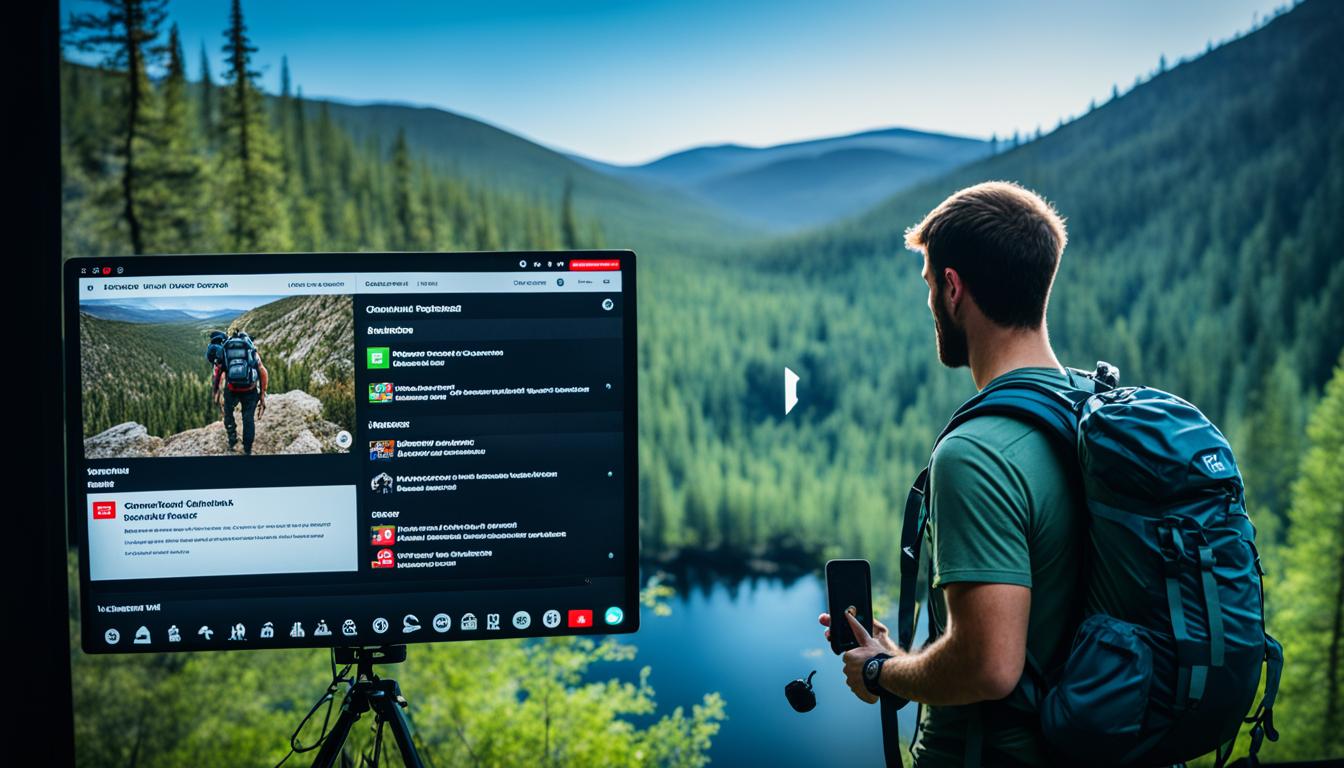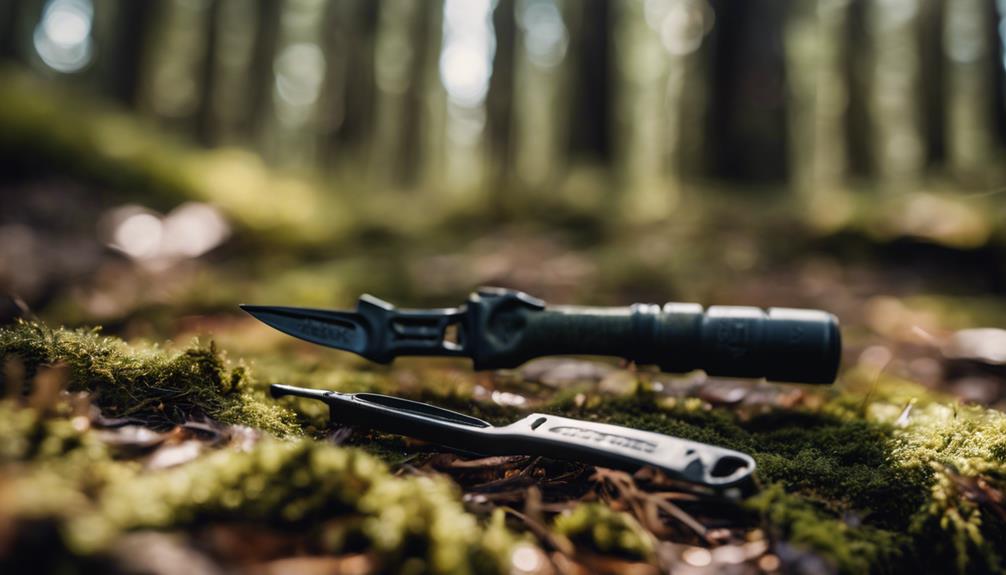Understanding stranger danger is crucial for your safety in various situations. Teach kids to identify safe individuals, like police officers or trusted adults, while emphasizing the importance of personal boundaries. Encourage them to stay alert, trust their instincts, and evaluate their surroundings for potential threats. Regular role-playing can help them practice responses to unsafe scenarios. Set up designated safe meeting areas and reinforce communication about safety at home. Instilling these skills boosts their confidence and preparedness for emergencies. You'll discover more insightful strategies to guarantee your family's safety in unpredictable situations.
Key Takeaways
- Teach children to identify safe adults, such as police officers and teachers, to seek help during emergencies.
- Encourage children to trust their instincts and maintain awareness of their surroundings to recognize potential threats.
- Role-play scenarios where children practice refusing offers from strangers and walking away from unsafe situations.
- Establish safe meeting areas and clear communication protocols for family members in case of emergencies.
- Reinforce the importance of keeping personal information private and discussing any uncomfortable interactions with trusted adults.
Understanding Strangers and Safe Individuals
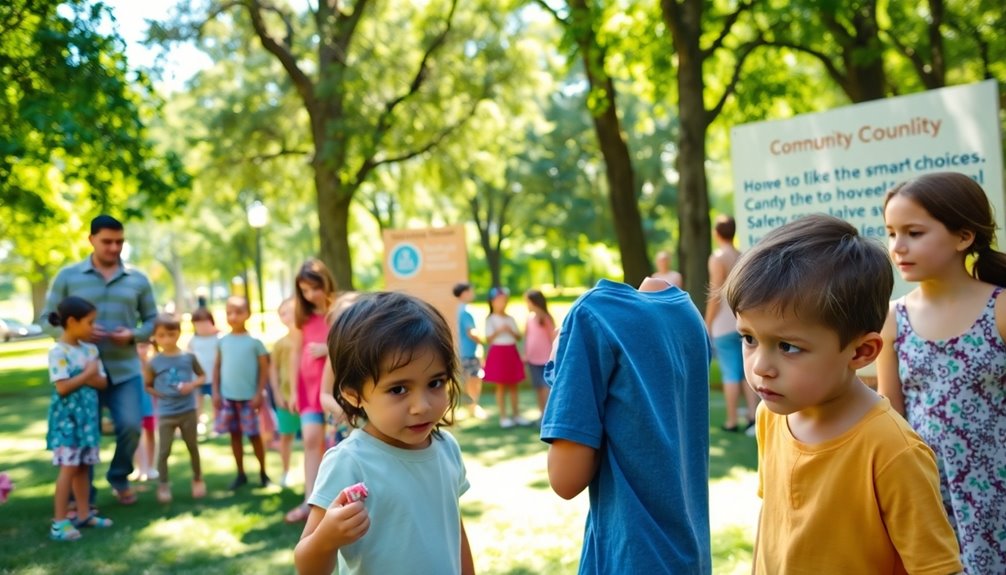
When it comes to safety, understanding the difference between strangers and safe individuals is essential. Strangers are people you don't know, and they can sometimes pose risks. Be cautious if a stranger offers you money, toys, or easy jobs. If someone asks you to leave a safe space or approaches you near their car, it's especially important to be wary. You should never answer the door when home alone or go anywhere with a stranger.
On the other hand, safe individuals include your parents, family members, and trusted adults. You can feel comfortable approaching uniformed personnel, like police officers, firefighters, or zoo employees if you need help. It's vital to identify safe spots and adults in public, such as store clerks or school staff. Neighbors who are well-known to your family can also be considered safe. Additionally, being aware of potential dangers posed by strangers can help you stay alert in unfamiliar situations.
Learn to recognize tricky behavior too. If someone makes you feel uncomfortable or tries to isolate you, it's a red flag. Always tell a trusted adult about any behavior that feels off. By understanding the difference between strangers and safe individuals, you can make smarter choices and stay safe in various situations.
Essential Safety Skills Training

To stay safe, you need to know how to identify safe individuals and respond to potential lures effectively. Practicing real-life scenarios can help build your confidence and prepare you for unexpected situations. Let's explore these essential skills that can empower you to make quick and informed decisions when it matters most. Additionally, understanding how to start a small fire can be crucial in signaling for help during an emergency.
Identifying Safe Individuals
Identifying safe individuals is essential for steering through potential dangers in unfamiliar situations. Start by looking for people in uniforms or with name tags, as they're often authority figures or workers who can help. Parents or caregivers with children are generally trustworthy, so don't hesitate to approach them if you need assistance. Law enforcement personnel, like police officers, are reliable sources of help in emergencies.
Safe locations are just as important as safe individuals. Convenience stores, libraries, and community centers usually have trustworthy adults ready to assist you. Stay in public areas with high foot traffic and visible security, as these spots are typically safer than isolated places. Look for security cameras and emergency phones, which offer an added layer of safety. Additionally, understanding the concept of survival priorities helps you assess the urgency of your situation and make informed decisions about whom to approach.
Using visual cues can help you identify trustworthy people. Uniforms, badges, and official clothing indicate a safe individual. Name tags or identification cards verify their role. Environments with other families or children often feel safer, too. Practicing these skills will empower you to make smart choices in potentially dangerous situations, ensuring your safety when you need it most.
Responding to Lures
Stranger lures can pose serious risks, and knowing how to respond effectively is essential for your safety. When you're in public, always stay alert. Avoid walking alone, especially in isolated areas, and be cautious of strangers approaching or following you. If someone in a car tries to engage you, don't approach them. Instead, keep your distance and move towards a well-lit, populated area.
Online safety is just as important. Never share personal information or your location with unknown individuals. Be skeptical of unsolicited messages, and use privacy settings to protect your online presence. If you encounter suspicious interactions, report them to an adult or authority.
In emergencies, seek help from trusted individuals or authorities rather than strangers. Always inform someone about your itinerary before heading out, and maintain awareness of your surroundings. Familiarize yourself with basic safety skills and first aid to handle emergencies independently. Additionally, practicing these skills regularly can enhance your preparedness, just like fishing practice improves survival fishing techniques. Remember to keep a well-stocked emergency kit at home and in your car, and make sure to periodically check and replenish its contents. Stay informed about potential hazards and emergency procedures in your area, and participate in community emergency preparedness drills and training. These emergency preparedness tips can greatly improve your ability to handle unexpected situations and ensure the safety of yourself and those around you.
When it comes to communication, never answer the door alone, and let your parents deal with unknown phone calls. Use a buddy system when you're out, and know a safe zone to retreat to if you feel unsafe. Your safety is your priority, so trust your instincts.
Practicing Real-Life Scenarios
Practicing real-life scenarios is crucial for equipping children with essential safety skills. Role-playing various situations helps kids retain important lessons better than mere discussions. For instance, practice scenarios where a stranger offers a ride or an unfamiliar adult approaches them at the park. Encourage your child to say "No" loudly and confidently, then move to a safe place. This builds not only confidence but also prepares them for real encounters.
Teach your child to identify safe adults like police officers, teachers, or store employees. Explain the importance of staying with a group and knowing where to find safe places, such as a trusted adult's home or a busy public area. Role-play finding a safe adult when feeling threatened or lost.
Encourage your child to trust their instincts; if something feels off, it probably is. Reinforce the importance of personal boundaries by practicing polite refusal skills. Remind them that it's okay to say "No" to anyone, even if it seems rude. Finally, cover online safety by teaching them not to share personal information with strangers, ensuring they feel comfortable discussing any uneasy encounters. Additionally, emphasize that being aware of stranger danger can empower them to make safer decisions in public spaces.
Establishing Safe Meeting Areas

In any emergency situation, having established safe meeting areas can greatly enhance your group's chances of staying together and staying safe. Choose locations that are easily accessible and memorable, especially for kids. For home evacuations, a nearby landmark, like a mailbox or light post, works well. In public areas, opt for central spots like a water fountain or a colorful store that everyone knows.
Designate a safe space within your home for immediate emergencies, such as an interior room or basement. Avoid dangerous neighborhoods and make sure your meeting spot is free from hazards. It's wise to have a secondary rendezvous point in case the primary one becomes inaccessible. Having a designated spot increases group size for safety during survival scenarios.
Establish clear communication protocols, so everyone knows where to meet. Use visual or audible signals to inform group members of the location. Set up a communication schedule to keep everyone updated, and share information regularly.
Consider practical aspects like the time of day and potential challenges in reaching your meeting area. Make certain it has necessary supplies, like first aid kits and water. Practice the plan with your group so everyone feels prepared and knows exactly what to do.
Responding to Threatening Situations

When you sense a threat, it's essential to recognize the warning signs and know how to react. Escaping unsafe situations quickly can make all the difference, so always have a plan in mind. Remember, finding immediate help from a safe adult can turn a frightening moment into a manageable one. Additionally, being aware of wilderness hazards such as extreme temperatures and UV radiation can further enhance your safety and decision-making in outdoor environments.
Recognizing Threatening Behaviors
Recognizing threatening behaviors is essential for staying safe in potentially dangerous situations. By enhancing your situational awareness, you can spot signs of danger before they escalate. Pay attention to your surroundings and the behavior of people nearby. If something feels off, trust your instincts. Situational awareness is key to detecting changes in environment or group dynamics, which can indicate emerging threats.
Here's a quick reference table to help you identify threatening behaviors:
| Behavioral Cues | Possible Threat Indicators |
|---|---|
| Furtive glances | Someone's trying to hide their intentions |
| Clenched fists | Signs of aggression or tension |
| Avoidance of eye contact | Evasion, discomfort, or dishonesty |
| Erratic body language | Unpredictable or nervous behavior |
| Hostile verbal cues | Direct threats or aggressive language |
Monitor group dynamics as well; watch for signs of aggression or unusual activities among those around you. Verbal cues can also be telling; listen for hostile comments or a disregard for authority. By being vigilant and evaluating both body language and verbal cues, you can better prepare yourself to respond effectively to potential threats.
Escaping Unsafe Scenarios
After identifying threatening behaviors, it's important to know how to escape unsafe scenarios effectively. Start by evaluating your surroundings. Identify potential escape routes and exits, and assess the immediate danger. Decide whether to evacuate or shelter in place, and plan to get outside any perimeter of containment quickly. Trust your instincts and use common sense to guide your decisions.
When it's time to escape, employ effective techniques. Make random turns, especially left turns, to confuse any attacker. Use simple self-defense moves, like stepping backward to throw them off balance, while avoiding aggressive behavior to prevent escalation. Look for tools around you—like a knife or box cutter—that can aid your escape. Additionally, maintaining situational awareness is crucial to reduce the risk of surprise attacks and ensure a safer escape.
Managing stress is essential too. Training for emergencies helps your muscle memory kick in when panic sets in. Remember, you might experience a loss of IQ and fine motor skills, so stay calm. Always have a pre-packed kit with essentials, and know the location of exits, especially in confined spaces. By blending in with your environment and using available resources wisely, you can maximize your chances of escaping safely.
Finding Immediate Help
In a threatening situation, knowing where to find immediate help can make all the difference. First, identify safe helpers around you. Look for uniformed employees like zoo workers or park rangers, and don't hesitate to approach police officers or firefighters. These individuals are trained to assist you and guarantee your safety. Remember that calling 911 for immediate emergency assistance is crucial in potentially life-threatening scenarios.
Next, familiarize yourself with emergency services. If you're in a life-threatening scenario, calling 911 is imperative. For emotional distress, reach out to the National Suicide Prevention Lifeline at 1-800-273-TALK. It's essential to know these numbers and what to say when you dial them.
Lastly, recognize safe locations where you can seek refuge. Designate meeting spots, like a specific store entrance, where you can regroup if separated. Safe spaces such as police stations or trusted businesses are important to remember.
By focusing on these three key elements, you can better equip yourself to respond effectively in threatening situations:
- Identify uniformed helpers (e.g., police, park rangers).
- Know emergency contact numbers (e.g., 911, helplines).
- Recognize safe locations (e.g., police stations, information desks).
General Safety Guidelines for Children

As a parent or caregiver, ensuring your child's safety is a top priority, especially in an unpredictable world. Start by teaching them essential road and traffic safety. Remind your child to look right, look left, and look right again before crossing any road. They should only cross when holding an adult's or older child's hand and avoid running near roads. If there's no sidewalk, encourage them to face traffic while walking.
Discuss stranger danger and social safety. Emphasize that they should never go anywhere with a stranger and to trust their instincts. If something feels off, it likely is. Encourage your child to stay with a group for safety and to say "No" loudly if approached by a stranger, then move to a safe place. Teach them to identify safe adults, like police officers or teachers. Additionally, make sure they understand the significance of having a safety word for identification in case they ever need to verify a trusted adult's intentions. It is also important to note that strong emotional regulation skills can help children manage fear and anxiety in unfamiliar situations.
Establish general safety rules, like contacting emergency services if they feel lost or in danger. Demonstrate safe behaviors, as kids often mimic adults. Consistently repeat these safety rules and engage in fun activities to reinforce their understanding. By managing their environment, you’ll help them explore confidently while staying safe. Consider creating a safety kit that includes basic first aid supplies, like band-aids and antiseptic wipes, to show them how to handle minor injuries. Teaching them basic first aid for young kids, such as cleaning and covering a cut, will empower them to take care of themselves in small emergencies. By incorporating these skills into their daily routines, you can ensure their safety and instill a sense of responsibility.
Testing Safety Skills in Real Life
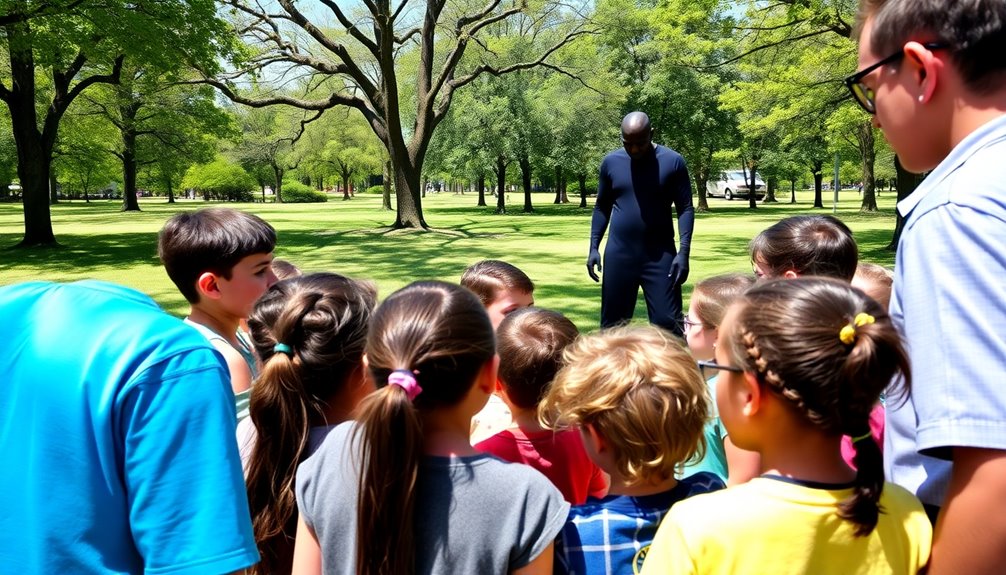
Testing safety skills in real life is essential for empowering children to navigate their environments confidently. By putting these skills into practice, kids can better recognize safe and unsafe situations, reinforcing their ability to make smart choices. Here are three key areas to focus on:
- Identifying Safe and Unsafe Situations: Teach your child to spot signs of danger, such as broken equipment or suspicious behavior. Help them understand which areas are safe, like well-lit places with trusted adults nearby. Additionally, remind them that the odds of abduction are extremely low, with only about 100 children kidnapped by strangers annually.
- Practicing Safety Skills in Daily Routines: Incorporate safety discussions during everyday activities, like crossing streets or shopping. Make it a habit to stay alert and practice safe walking techniques, ensuring they can confidently navigate their surroundings.
- Utilizing Trusted Authorities for Help: Encourage your child to identify helpful adults in their community, such as police officers and store clerks. Teach them how to seek help if they're ever lost and the importance of waiting in designated spots until assistance arrives.
Role-Playing Scenarios for Practice
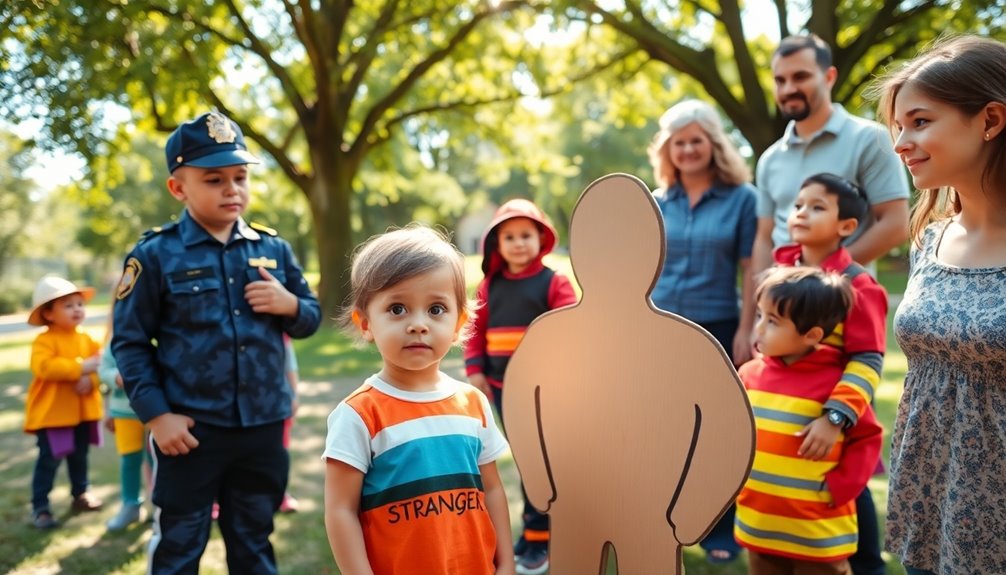
Practicing safety skills through role-playing scenarios can greatly enhance a child's ability to handle real-life situations involving strangers. When you engage your child in these activities, they're more likely to retain essential safety lessons than if you simply discuss them. Create scenarios where a stranger offers a ride or asks for help, like saying, "Can you help me find my dog?" Encourage your child to say no, walk away, and seek a trusted adult.
Help them identify strangers and differentiate between familiar faces. Role-play what to do if a stranger approaches, emphasizing the importance of saying no loudly and moving to a safe place. Incorporate safe adults, like police officers or teachers, into these scenarios so your child knows who to turn to if they feel unsafe.
Make these role-playing exercises varied and realistic. Use settings like parks or shopping centers, and include different lures, such as gifts or requests for help. This not only builds confidence but also prepares your child for real-life interactions with strangers, reinforcing that while not all strangers are dangerous, caution is always necessary. Additionally, it is crucial to emphasize that 90% of child abductions involve someone known to the child, highlighting the importance of being aware of their surroundings.
Reinforcing Safety Knowledge Regularly

Reinforcing safety knowledge regularly is crucial for helping children remember essential skills in real-life situations. When you repeat safety concepts and engage in practical exercises, you increase retention to about 80 percent. Regularly practicing these concepts guarantees that kids don't just learn them but can recall them when it matters most.
To effectively reinforce safety knowledge, consider these three strategies:
- Integrate Activities: Use storybooks and drawings to illustrate safe and unsafe situations. Create fun exercises that encourage kids to identify risks in their environment.
- Practice in Real Life: Regularly practice safety rules in everyday scenarios, like stores or parks. This helps them understand how to apply what they've learned, especially when encountering safe strangers.
- Encourage Reflection: After practicing, ask children to discuss how they'd use their new skills in real-life situations. Engage them in "what if" scenarios to deepen their understanding and preparedness.
Encouraging Open Communication About Safety

Open communication about safety helps children feel empowered and informed. Encourage them to differentiate between safe and unsafe strangers by identifying safe adults, like police officers and teachers. Role-playing different scenarios can reinforce these lessons, such as staying close to you in public places. Always stress the importance of keeping personal information private—no sharing names, addresses, or phone numbers with strangers.
Make safety discussions age-appropriate and engaging. Use simple language, read books on stranger safety, and clarify that adults should ask other adults for help, not children. If they ever feel lost, remind them to stay in one spot. Approximately 4,600 children abducted by strangers annually emphasizes the need for these conversations to be proactive and ongoing.
Foster an environment where your child feels comfortable sharing any interactions with strangers. Teach them to trust their instincts; if something feels off, it's okay to speak up. Equip them with specific actions to take if approached, like yelling for help or making a scene.
Involve them in practicing these rules through role-playing. Guarantee they memorize important contact information and know to seek help from trusted authority figures if needed. Reinforcing these messages regularly helps create a culture of safety awareness.
Frequently Asked Questions
What Age Should Children Start Learning About Stranger Danger?
You should start teaching children about stranger danger around preschool age, around 3-5 years old. At this stage, focus on simple concepts like their name and address, using terms like "tricky person" to make it relatable. As they grow, around 6-7 years, introduce the "No-Go-Tell" method and reinforce safety rules. By 8-9 years, deepen their understanding of trust and instincts, ensuring they know the importance of staying safe in various situations.
How Can I Identify Safe Places in Unfamiliar Areas?
When you're lost, finding safety is like searching for a lighthouse in a storm. To identify safe places, look for natural shelters like the leeward side of hills, avoiding low-lying areas that could flood. Stay clear of hazards like dead trees or loose rocks. Following waterways can lead you to civilization, but always guarantee the water is safe to drink. Mark your path, and use landmarks to navigate back to safety.
What Should I Do if My Child Refuses to Participate in Training?
If your child refuses to participate in training, try to understand their concerns. Engage them in conversation about why they're hesitant. Instead of forcing participation, make it fun and interactive. Involve them in planning the activities to boost their interest. Use relatable scenarios or role-playing to demonstrate the importance of the skills. Remember, creating a positive environment will encourage them to feel comfortable and more willing to participate in the training.
How Can I Teach Children to Recognize Trustworthy Adults?
When you're out and about, it's crucial to help your child spot trustworthy adults. Point out people wearing uniforms, like security guards or store employees, as safe individuals. Explain that mothers with children can be good allies too. Encourage your child to trust their instincts; if someone feels off, they should seek help from a nearby adult. Reinforce the idea that it's okay to be cautious around unfamiliar faces.
Are There Specific Resources or Materials Available for Teaching These Skills?
Yes, there are specific resources and materials you can use to teach these skills. Consider utilizing engaging books like *Never Talk to Strangers* or *The Berenstain Bears Learn About Strangers*. Visual aids such as charts can help reinforce safety tips. Educational videos and handouts can also enhance learning. Additionally, connect with community members for real-life insights and support, creating a thorough approach that encourages discussion and practical application of safety concepts.
Conclusion
In the end, equipping kids with the tools to navigate the world is like giving them a sturdy compass in a dense forest. By instilling smart choices and safety skills, you empower them to spot danger lurking in the shadows and find their way to safety. As they practice through role-playing and open conversations, they transform into confident explorers, ready to face the unknown with a bright light of knowledge guiding their path. Keep the dialogue alive; it's essential.




